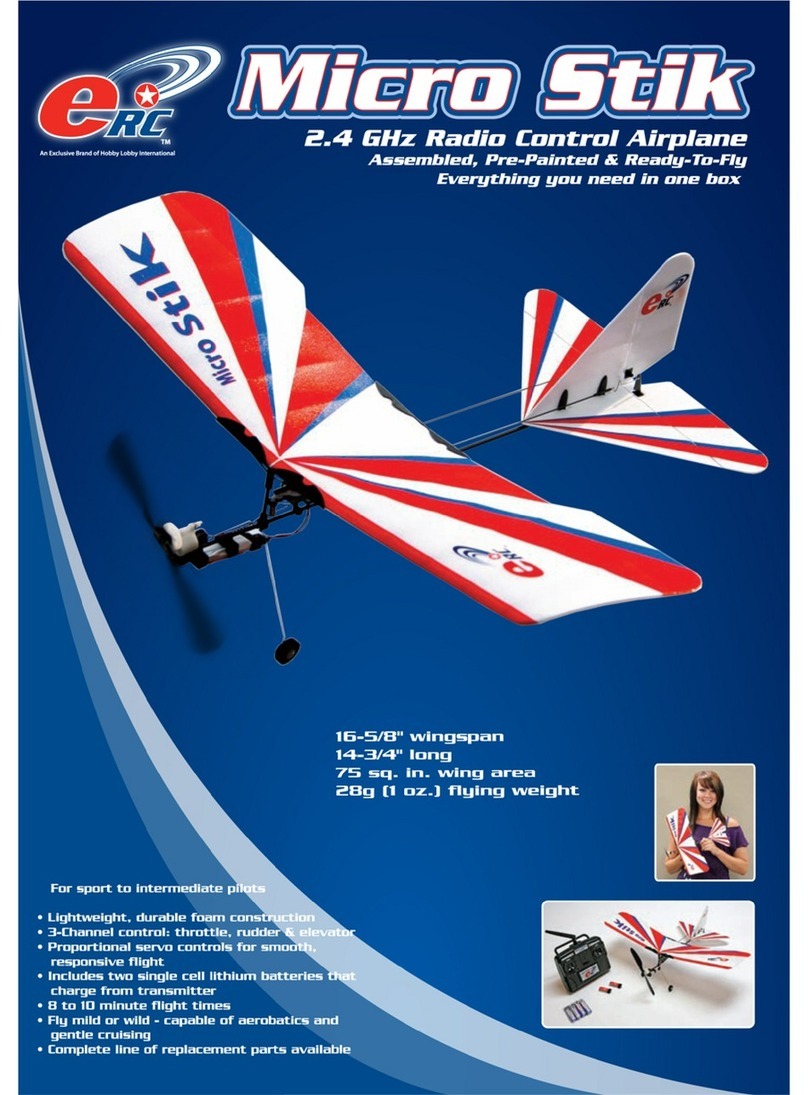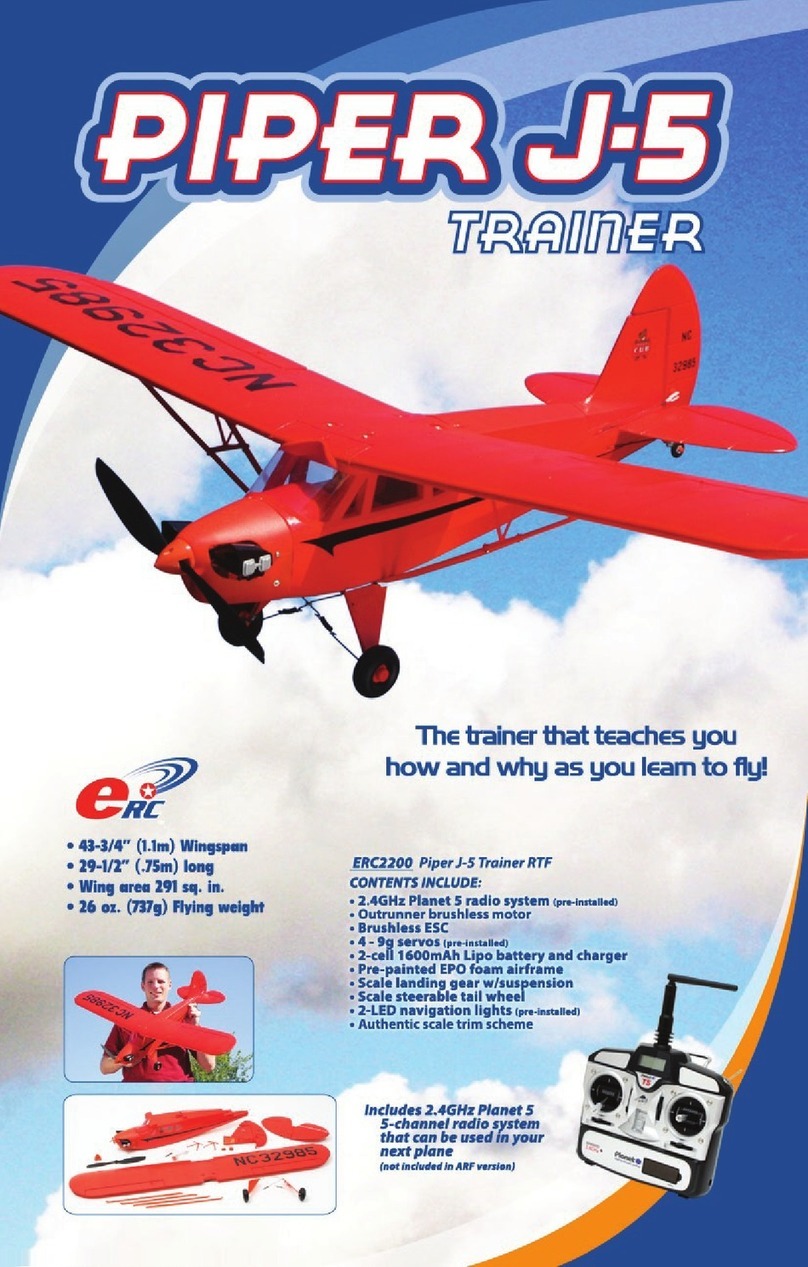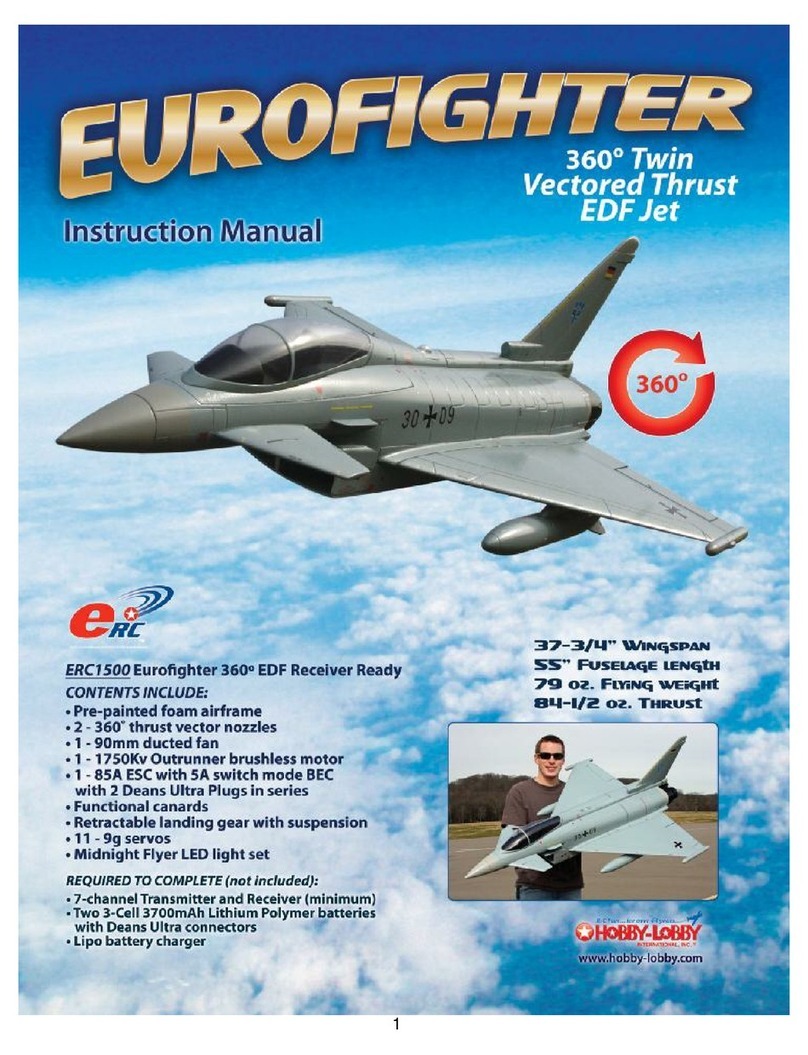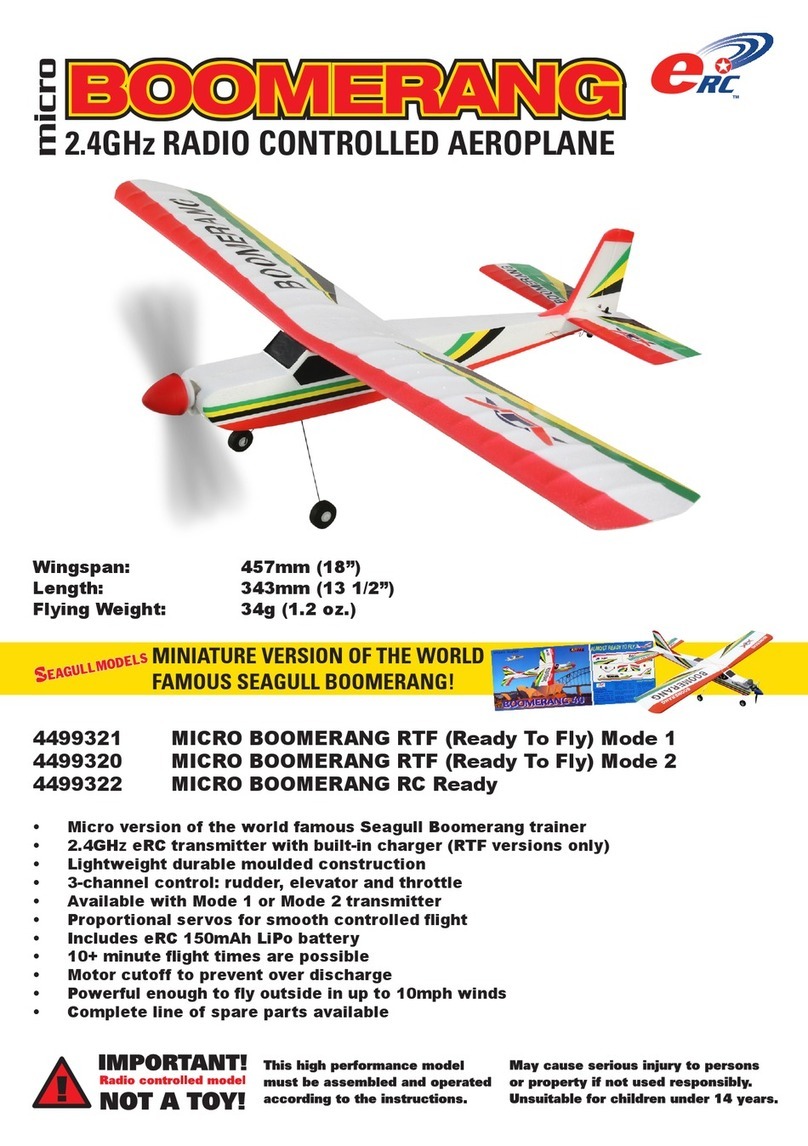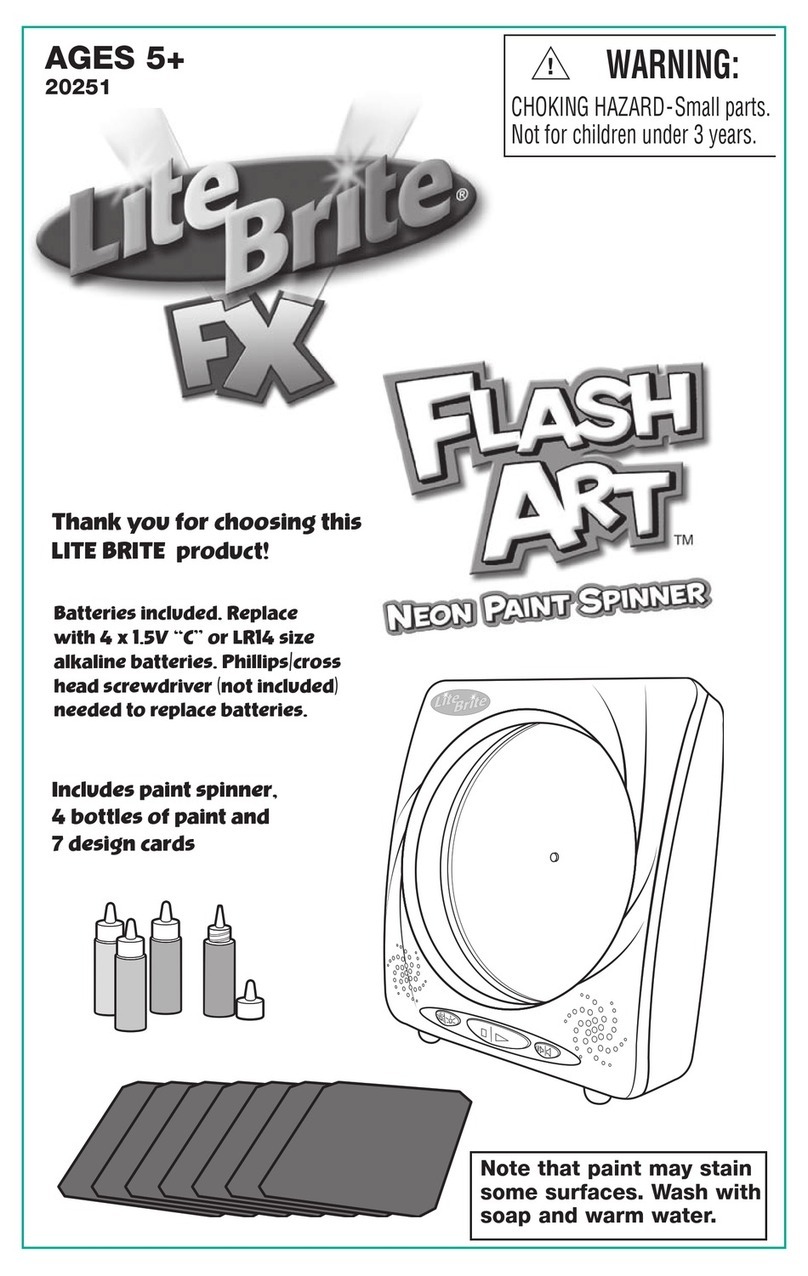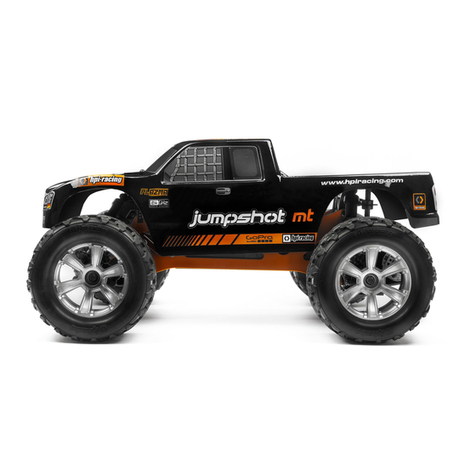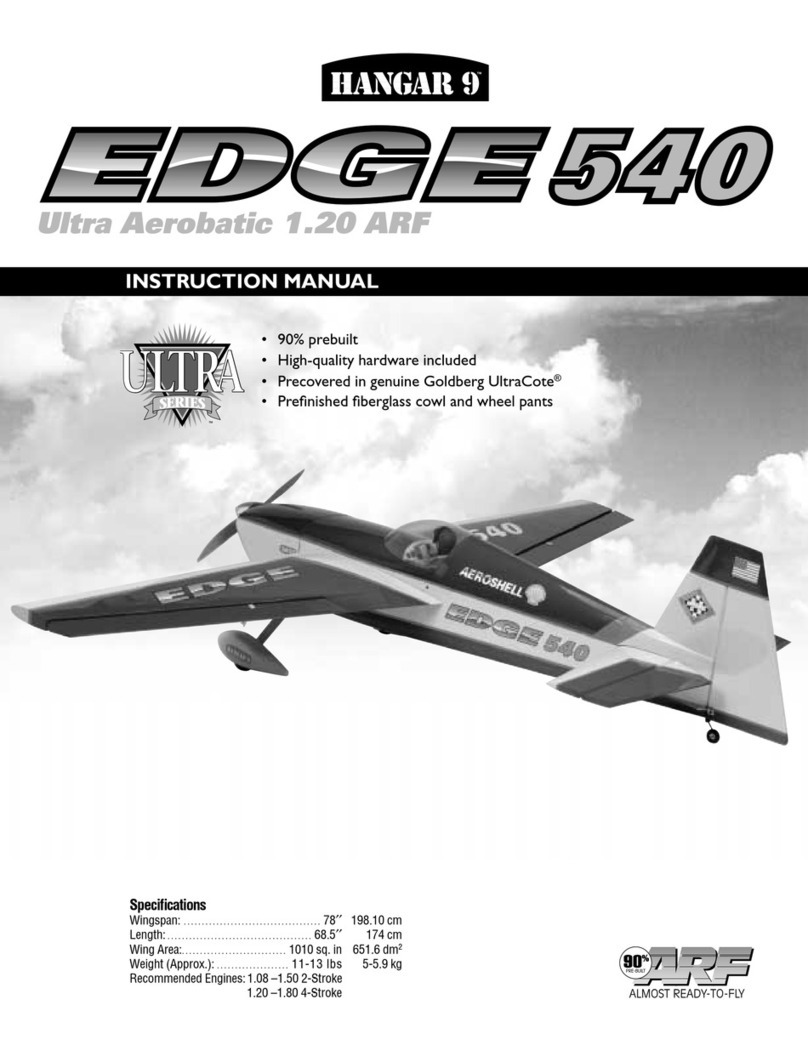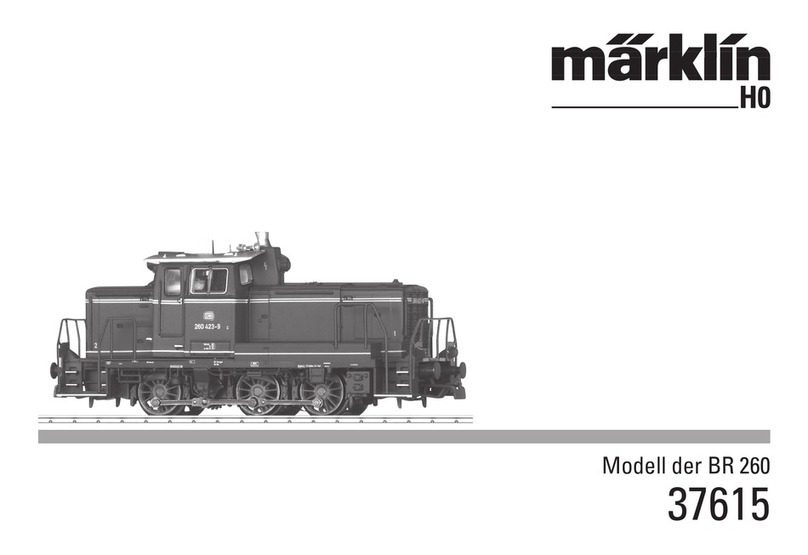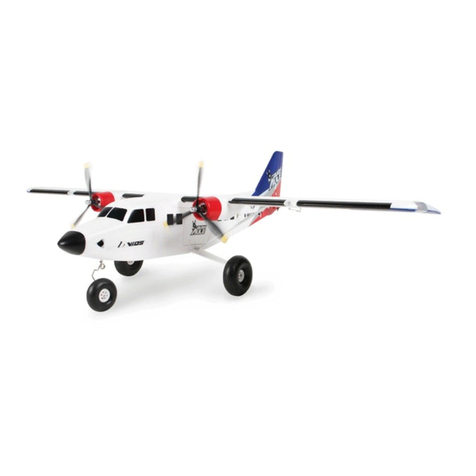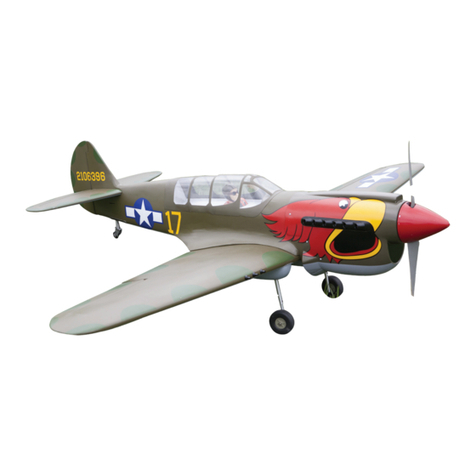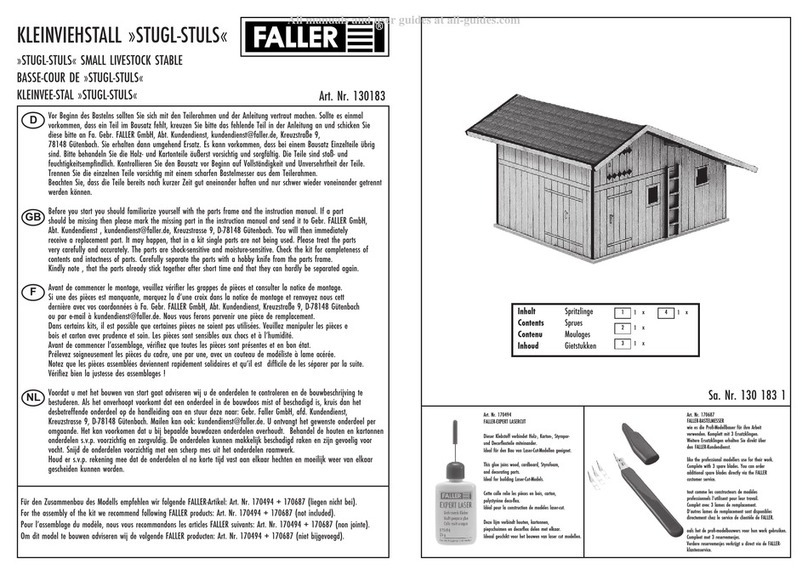erc Micro Stik User manual


Items Included With Your Model:
Transmitter
AA batteries (4)
Assembled aircraft
Li-Po battery (2)
Streamer
Install the Transmitter Batteries
Open the rear cover of the transmitter.
Insert the four AA batteries noting the
polarity of the batteries molded into the
transmitter case. Replace the cover on
the transmitter.
Charging the Flight Battery
Open the door on the transmitter to access
the charger lead. Connect the lead to the
ight battery making sure the red dots are
aligned.
The transmitter can be in either the ON or
OFF position while charging a battery.
If the battery is charging correctly, a yellow
light on the transmitter face will light. When
charging is complete, the yellow light will
go off.
Transmitter Battery Check
When charging with the power switch in
the ON position, the signal that the AA
transmitter batteries need to be replaced
will be an audible beep. When charging with
the power switch in the OFF position, the
yellow light will become dim when the AA
transmitter batteries are running low.
Note: If you are ying your model while the
transmitter battery power becomes low, stop
ying immediately and replace the batteries
in the transmitter.
Install the Flight Battery
Once the ight battery has charged, insert the
battery in the battery holder as shown. Make
sure the red dots are aligned.
Make sure the connector on the battery is
aligned properly to the plug in the fuselage.
Take care not to force the battery in the
fuselage. Use only the supplied battery or
ERC replacement part. Other batteries may
damage the radio system.
Make sure that the coloured dots are lined up on
the battery and charge lead. Plugging the battery in
the wrong way round may damage the pins on the
battery.and is not covered by the warranty.

Binding the Model
Your model is shipped ready to y. If you nd the
ontrols are not responding to the transmitter, it may be
necessary to bind the radio system. Use the following
to bind the radio system.
1. Turn on the transmitter
2. Install the ight battery and connect the plug
3. Momentarily depress the 2 trim buttons on the
throttle stick Note: Throttle is on the right for Mode
1 and left for Mode 2.
Note: You do not need to hold them down
4. The airplane will indicate that it is bound by moving
the controls
5. Check that the control surfaces are moving in the
correct direction
Control Throw
Make sure the controls for your model operate
correctly.
Elevator Control
Moving the elevator stick (mode 2-right, mode 1-left)
to the top of the transmitter will make the elevator
move down. In the air, this will cause the plane to dive.
Moving the stick toward the bottom of the transmitter
will make the elevator go up. In ight this will make the
model climb.
Rudder Control
Moving the right stick to the right will make the rudder
go right. In ight this will make the model turn to the
right. Moving the stick to the left will make the rudder
go left. In ight this will make the model turn to the left.
Throttle Control
Moving the throttle stick (mode 2 - left, mode 1 - right)
to the top of the transmitter will operate the motor.
The throttle is proportional, so as you move the
throttle stick up, the speed of the motor will increase,
which increases the ying speed of the model. We
recommend ying at 1/4 to 2/3 throttle for your rst
ight to learn the ying characteristics of your model.
Mode 1
Down Elevator
Mode 2
Mode 1Mode 2
Up Elevator
Mode 2 and Mode 1
Left Aileron
Mode 2 and Mode 1
Right Aileron
Throttle
Mode 2 Mode 1
Note: Your radio does have a 4th channel, but is not a
function designed into this particular model.

Flying Your Model
Your model has been designed for the intermediate modeler
who is familiar with the use of a four-channel radio system.
It is available in Mode 1 and Mode 2. Always perform a
range and ight check to make sure all controls are operating
properly before ying your model.
Range check:
Connect the Li-Poly battery to the aircraft, before turning on
the TX press CH3-, keep the button pressed down and turn
on the transmitter. You will hear 5 consecutive tones, you are
now in range check mode. 10 metres distance from the model
in range check mode is equivalent to around 100 metres
range in normanl ying mode. Move the transmitter sticks to ensure all channels are working. To return
to normal ying mode turn off the transmitter and turn it back on again, you will hear 3 beeps to conrm
you are back in normal ying mode.
Setting the trim before ight
It may be neccessary to ne trim your model before ight, with all transmitter sticks in neutral all control
surfaces should be at neutral position.
✔ ✖
DIGITAL TRIMS:
CH2: Elevator trim buttons
(+ for up and - for down)
CH3: Throttle trim buttons
(+ for increase and - for decrease)
CH4: Rudder trim buttons
(+ for right and - for left)
Ch1 - Ch1 + Ch4 - Ch4 +
Ch3 -
Ch3 +
Ch2 -
Ch2 +
Mode 2
Ch1 - Ch1 + Ch4 - Ch4 +
Ch2 -
Ch2 +
Ch3 -
Ch3 +
Mode 1
Servo reverse
Servo directions are factory set and should move in the correct direction. To reverse servo direction
follow this procedure:
Ch2 Elevator servo reverse: Press Ch1+ and Ch2+ or - simultaneously
Ch4 Rudder servo reverse: Press Ch1+ and Ch4+ or - simultaneously

Trimming the Model in ight
If you nd that your model does not y
straight, it may be necessary to adjust
the trim for straight and level ight.
Trimming is best done when ying at
1/2 to 2/3 power.
Rudder Trim
If the model appears to turn slightly to
the right or left, it may be required to
adjust the rudder trim. If the model is
turning to the left, press the right rudder
trim until the model ies level. If it is
turning to the right, press the left rudder
trim. You should only use one or two
presses at a time so the model is not
over-trimmed and begins turning the
opposite direction.
Elevator Trim
If the model is climbing or diving in
ight, it may be necessary to adjust the
elevator trim. If the model is climbing,
you will need to press the down
elevator trim. If the model is diving,
it will require that you press the up
elevator trim. As with the rudder, only
press the trim once or twice until the
model ies level to avoid over-trimming.
NOTE: If you reach the end point of the
trim you will hear a continuous beep.
Flying Area
You can y your model indoors in an area the size of a
small gymnasium, or outdoors in a similar sized area or
larger in winds less than 5 mph. Make sure to choose an
area that is clear of buildings, trees, power lines or other
obstacles that your aircraft could collide with. Always
y your model away from crowds or spectators to avoid
injury.
General Flying Precautions
Always make it a point to practice good ying
techniques. Choose an area large enough
that you can safely maneuver your model.
Always y your model in winds of 5 MPH or
less. Avoid ying into the sun.
Mode 1 and Mode 2
Model rolls left, add right trim
Model rolls right, add left trim
Mode 1 and Mode 2
Mode 1
Model dives, add up trim
Mode 2
Model climbs, add down trim
Mode 2 Mode 1
Flight check:
Point the model into the wind. Advance the throttle to 2/3 power and gently “push” the model forward with
the nose up slightly. You can also take off from the ground on smooth surfaces such as gym oors or
driveways.
The Micro Stik can be own mild or wild. Slowly cruise around at 1/4 throttle or perform multiple loops
and tight turns at higher power settings.
To land, reduce the throttle enough to cause the model to slowly descend. Point the model into the wind
and y it gently to the ground. With a little practice you will be able to perform touch and goes.

Spare Parts
The product team at J Perkins hopes that you enjoy your new Micro Stik. Whether ying in your outdoors
or indoors we think that the Micro Stik is a model that you’ll be proud to show off to your friends and
ying buddies. If you ever need replacement parts, please refer to your local model shop using the part
numbers below. And don’t forget to visit our website regularly at www.jperkinsdistribution.co.uk so you
won’t miss our future Micro Series releases!
Part # Description
4499520 eRC MICRO STIK FUSELAGE & BRACKETS
4499521 eRC MICRO STIK WING & SUPPORT
4499522 eRC MICRO STIK TAIL SET & CONTROL HORNS
4499523 eRC MICRO STIK 130mAh LIPO
4499524 eRC MICRO STIK 150mAh LIPO (UPGRADE)
4499525 eRC MICRO STIK MOTOR & GEAR BOX
4499526 eRC MICRO STIK PROPELLER (2)
4499527 eRC MICRO STIK LANDING GEAR SET (MAIN & TAIL)
4499528 eRC MICRO STIK DECAL SET
4499530 eRC MICRO STIK TRANSMITTER (MODE 2)
4499531 eRC MICRO STIK TRANSMITTER (MODE 1)
4499532 eRC MICRO STIK PUSHRODS
4499533 eRC MICRO STIK RECEIVER & SERVO BOARD
4499534 eRC MICRO STIK PROPELLER SHAFT & SPUR GEAR
4499535 eRC MICRO STIK STREAMERS (3)
Warranty Information
For a period of one year from time of purchase, J. Perkins Distribution Ltd will repair or replace, at it’s
discretion, any items showing manufacturing or assembly defects that has been found faulty by our
service department. This does not affect your statutory rights.
J Perkins Distribution Ltd does not accept any liability for any injury, damage or consequential damage
arising as a result of failure to observe the procedures and precautions outlined in this manual. J
Perkins Distribution Ltd does not accept any liability that may arise from any misuse or modication of
this equipment, Please note that, whilst every effort is made to ensure the accuracy of instructions and
materials included with this product, mistakes can occur and neither J. Perkins Distribution Ltd nor it’s
distributors will be held liable for any loss or damage arising from the use of this system or for any loss
or damage arising from omissions or inaccuracies in the associated instructions, references, web sites or
materials included or referred to with this product.
We reserve the right to modify the design of this product, the box contents and manual without prior
notication. E&OE
© 2010 J Perkins Distribution Ltd. All rights reserved.
web: www.jperkinsdistribution.co.uk
Attaching the streamer
You can attach the streamer for added fun or for
combat with other Micro Stik pilots. Attach the end
with the loop around the tail wheel.

Safety Instructions for Charging and Using Li-Poly Batteries
• Do not put the battery on, or near anything, that can catch re when charging.
• Always charge the battery on a non-ammable base, i.e. a metal tray.
• Do not disassemble the battery.
• Do not short-circuit the battery.
• Do not use, or leave, the battery near a re, stove or heated place.
• Do not immerse the battery in water or seawater, do not get it wet.
• Do not charge the battery near a re or under the blazing sunlight.
• Do not drive a nail into the battery, strike it with a hammer or apply excessive weight to the battery.
• Do not impact or throw the battery.
Safety Precautions
1. Please do not change any part of the plane without checking with J Perkins (Dist) Ltd. You will be
responsible for any damages caused by these changes.
2. Your ying area should be wide-open and free of obstacles. Never y near highways, railways,
airports, power lines or in residential areas.
3. To avoid personal injury, never y your model near or facing people, or throw the plane in their
direction.
4. Do not y your model outdoors in winds over 5 MPH.
5. Never dispose of batteries or parts of your model in a re as it could lead to an explosion and personal
injury.
General Safety Statements
1. This aircraft is not a toy. It has been designed for the experienced modeler and pilot. You are
responsible not to cause damage to other’s personal property or cause personal injury.
2. J Perkins (Dist) Ltd and our dealers are not responsible for any economic or law liability for any
improper usage or operation of this model.
3. This model is designed for use by modelers age 14 and over. This model is not recommended for
unsupervised modelers under 16 years of age.
4. Never use the model or associated electronics in damp or rainy conditions.
5. This model is made from EPS and Polystyrene, which can be damaged by excessive heat. Keep your
model away from excessive heat, left in a hot car, and out of direct sunlight for extended time periods
or it can become warped and affect the ight performance of the model or damage the decals.
6. Never leave the battery connected while the model is unattended. Accidental operation can occur and
cause personal injury.
7. Before operating the model, make sure to turn on the radio system and check the functions before
beginning ight.
8. Always make sure the throttle stick on the transmitter has been moved to the low or off position before
connecting the motor battery.
EU regulations
J Perkins Distribution Ltd declares that this remote control system is in compliance with the essential
requirements and other relevant provisions of Directive 1999/5/EC on Radio equipment and
Telecommunications Terminal Equipment. A copy of the declaration(s) of conformity can be obtained
from J Perkins Distribution Ltd, Ashford rd, Lenham, Kent. UK ME17 2DL. This system complies with the
EU directive on Waste Electrical and Electronic Equipment. Do not dispose of this product in household
waste. At the end of the products’ life, dispose of it at a designated collection point for the recycling of
waste electrical and electronic equipment.
Please contact your supplier for any advice required on disposal.

Have Fun!
We hope that you have many pleasant ights with your Micro Stik!
J Perkins Distribution, Lenham, UK
www.jperkinsdistribution.co.uk
V7.10
Table of contents
Other erc Toy manuals
Popular Toy manuals by other brands
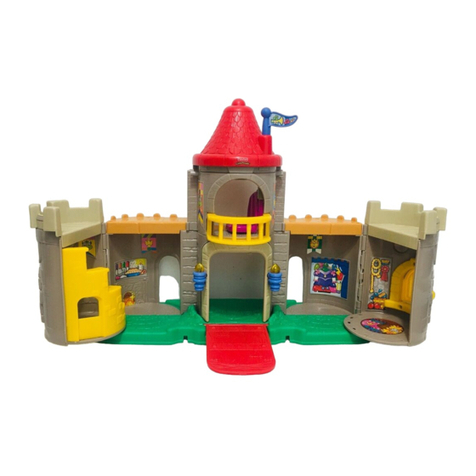
Fisher-Price
Fisher-Price Lil' Kingdom Castle C1159 instruction sheet

American Original Dollhouse
American Original Dollhouse Prairie Church Birdhouse Kit Assembly instructions

GREAT PLANES
GREAT PLANES fairchild PT-19 instruction manual
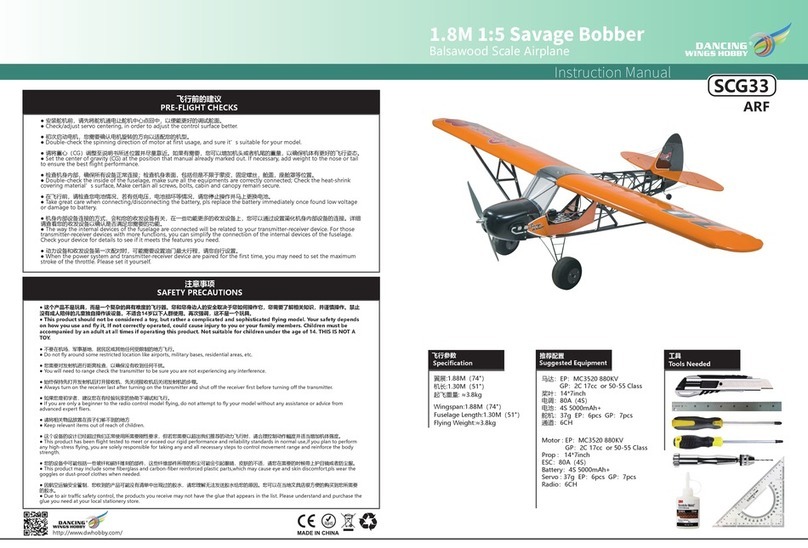
Dancing Wings Hobby
Dancing Wings Hobby 1.8M 1:5 Savage Bobber instruction manual
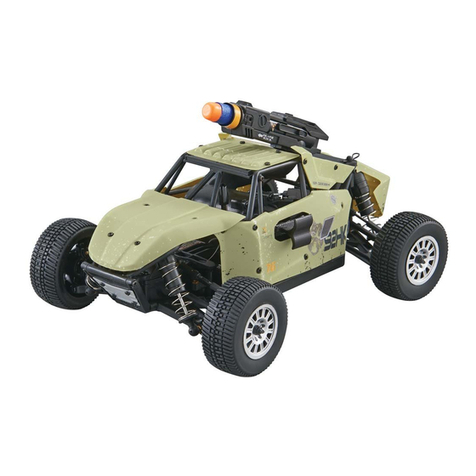
Dromida
Dromida Wasteland Buggy Assembly and maintenance guide

KidKraft
KidKraft Modern Country Kitchen manual
